Whether you need a solution for new product design, 3D printing, or visualization and simulation, 3D scanning can deliver high-quality results. Portable 3D scanners—whether handheld or stationary—offer a higher degree of control and more maneuverability than their bulky counterparts, making them a popular choice across a range of industries. But with a variety of providers and a plethora of devices on the market, how do you choose the right portable 3D scanner for your needs?
At Laser Design, a brand of CyberOptics® Corporation, we’re passionate about connecting people with the right solution for their needs. After more than 30 years in the 3D scanning and measurement business, we’ve seen and used quite a few scanning devices—and today, we’re sharing some of that knowledge. We’ve put together a quick guide to choosing a portable 3D scanner so that you can be better prepared to select the right device.
Assessing Your 3D Scanning Needs
It’s all too easy to be swayed by expensive systems packed with bells and whistles, but you might find that you don’t actually need all of those extra functions. Before you even start looking at portable 3D scanners, be sure that you have a clear idea of what your project requires.
First, take into account the size of the objects you’ll be scanning and your project timeline. What file format of 3D data will you need, and how quickly do you need to complete the scanning? Is color data a necessity, or more of a wish-list item? What are the smallest details that you need to capture? These are the kinds of questions that will help you nail down your requirements and recognize the right option when you find it. Ultimately, you should have specific levels of accuracy, speed, resolution, and usability in mind before starting to shop around.
Budget is another factor to consider. If you’ll be utilizing your portable 3D scanner for years to come, you’ll need high-quality equipment that will stand the test of time and remain competitive. This may merit spending more in the short-term in order to maximize your long-term productivity. But if your budget is set, you might want to look into budget-friendly or used portable scanners. We periodically have our own used scanners available for sale!
Choosing the Right Artec 3D Scanner
After you have a clear idea of the parameters of your search, it’s time to start looking at options. So, which portable 3D scanner is the best? The answer varies, but to us, there’s nothing more effective than an Artec scanner in terms of ease of use, quality, speed, and cost-effectiveness.
Artec scanners are eye-safe and can easily be used to scan everything from people and animals to small, delicate parts. There’s an Artec model to meet any need, from budget-friendly models to powerful, cutting-edge devices.
Artec Space Spider 3D ScannerIf you’re in the market for a handheld 3D scanner that can capture small objects with complex geometry, sharp edges, and tiny details, then the Artec Space Spider should be the first scanner you look at. This scanner boasts high-resolution 0.1 mm point spacing and can scan at a speed of 7.5 frames per second, making it the ideal choice for a variety of applications, such as new product design, part duplication via 3D printing, and rendering/visualization. Although originally designed to work in space, the low-cost, high-performance Space Spider will surprise you with how easy it is to learn and use. | 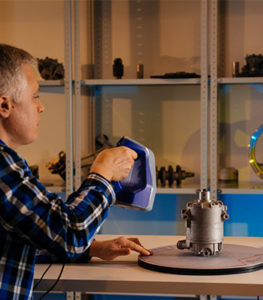 |
Artec Eva 3D ScannerThink of the Artec Eva 3D Scanner like a video camera—one that can capture three-dimensional images at up to 16 frames per second and with resolution up to 0.5 mm! Scanning with the EVA feels like filming home movies with a digital camera. With a high frame rate, a large field of view, and a high speed of up to 2,000,000 data points per second, the EVA is ideal for producing accurate and textured 3D models of medium to large-sized objects, such as human bodies, car parts, furniture, and more. Thanks to its high-performance output in a low-cost package, the EVA is the most popular Artec scanner out there, valued highly by industry professionals and hobbyists alike. The EVA is also noteworthy for having an optional Photogrammetry-based add-on that improves the accuracy of the 3D scan when needed. Artec Eva Lite 3D ScannerIf the Artec Eva meets your needs but not your budget, try the Eva Lite Scanner. This model features the same accuracy specs as the Artec Eva, but with some reduced functionality. Specifically, the Eva Lite offers geometry-only tracking and capture without the full-color scanning mode that the Eva has, meaning that this device can be used to make high-quality textureless 3D scans from geometrically-rich objects, like the human body. And because it doesn’t capture color, the Eva Lite collects significantly less data, resulting in less power use. This is the best entry-level scanner for orthopedic and prosthetic applications. | 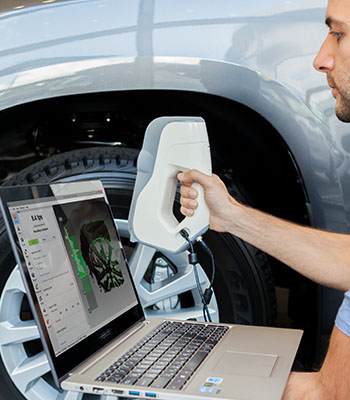 |
Artec Leo 3D ScannerNeed unparalleled speed, mobility, and versatility for your project? Check out the Artec Leo 3D Scanner, the first truly handheld, portable 3D scanner to offer onboard automatic processing. A powerful embedded processor, built-in battery, large field of view, integrated touch screen, and wireless connectivity make this scanner one of the smartest and most versatile devices on the market. Whether you’re using it to quickly process large objects or capture fine details—or both—the Leo will deliver high-quality 3D scans at breakneck speeds. | 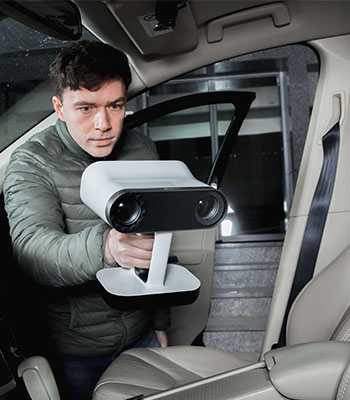 |
Artec Ray 3D ScannerThose who need an affordable long-range scanner should look no further than the Artec Ray, a compact, easy-to-use 3D scanner that comes in at half the cost of other comparable long-range systems. The Ray can be activated via WiFi and managed via mobile and tablet devices, making it extremely easy to operate. This scanner can be used to capture large objects from up to 110 meters away, both indoors and outdoors. Opt for this model if you need a high-performance, long-range scanner that offers minimal post-processing time and submillimeter precision. We’ve seen this scanner used for everything from reverse engineering to product design in industries like engineering, forensics, and construction. Training for this device takes just two to four hours and can be done online via webinars or video conferencing. | 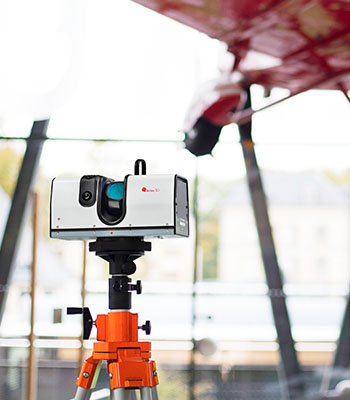 |
Artec Micro 3D ScannerIn complement to the portable Eva, Space Spider, Leo, and Ray, Artec also offers a powerful and easy-to-use desktop 3D scanner called the Artec Micro. This tabletop, semi-automated 3D scanner is noteworthy for maximizing the scan data accuracy and resolution for small objects in industries such as jewelry, dentistry, and 3D printing. Although the Micro has the smallest work volume of the Artec family, the low price point makes it the ideal scanner to look at if you need the maximum level of detail for small parts like rings, pendants, dental models, fossils, and small mechanical parts—just to name a few. Additionally, the increases in accuracy and resolution make this an excellent low-cost model for small part inspection applications. | 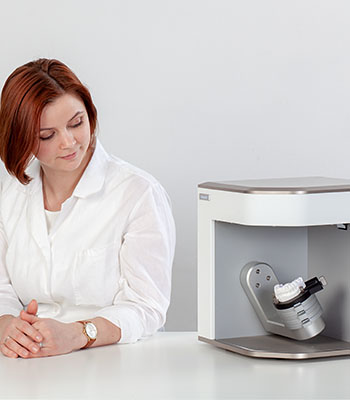 |
What to Look for in a Portable 3D Scanner Provider
Not all providers of 3D scanners and 3D scanning services are created equal. You deserve a provider that values your business as more than just money in the bank. While you’re researching companies, be sure to check out warranty information, compare pricing, chat with a representative, and see a demonstration if possible
At Laser Design, we don’t just mail your Artec scanner and wish you luck—we’ll be there to guide and support you every step of the way. Whether you need in-depth instruction on using a scanner or are just interested in learning more about the ROI of 3D scanning, we can tell you what you need to know.
Artec 3D Scanners from Laser Design
We’re dedicated to providing the ideal solution for projects big and small, and our collection of Artec portable 3D scanners boasts a device for just about every application. Contact Laser Design, a Gold Certified Artec Partner, today for more information on our Artec products and 3D scanning services. We look forward to helping you with your next project!
